About Poland: Culture & Traditions
Poland is a country rich in history, traditions, and cultural heritage. Understanding Polish culture, social norms, and customs will help you integrate better into Polish society and build meaningful relationships with locals. This comprehensive guide covers everything from daily social interactions to major holidays and traditions that shape Polish life.
Table of Contents
Understanding Polish Culture
Polish culture is deeply rooted in history, family values, and Catholic traditions. Despite centuries of foreign rule and political upheaval, Poland has maintained a strong national identity characterized by resilience, hospitality, and pride in cultural heritage.
Poles are generally warm and welcoming to foreigners, especially those who show genuine interest in Polish culture and history. The concept of "gościnność" (hospitality) is fundamental to Polish culture - guests are treated with exceptional care and respect.
Family plays a central role in Polish society. Extended families often remain close, and multi-generational gatherings are common during holidays and special occasions. Respect for elders and strong family bonds are deeply ingrained values.
Education and intellectual pursuits are highly valued. Poland has a strong literary tradition, and many Poles are well-read and interested in discussing history, politics, and culture. The country has produced notable figures like Copernicus, Chopin, and Marie Curie.
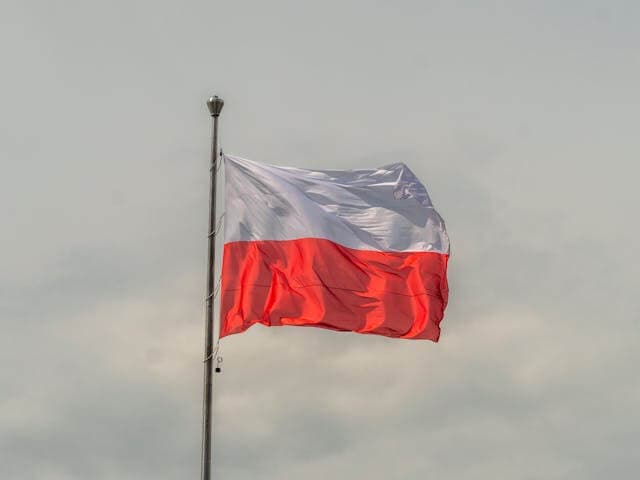
Polish flag
Key Cultural Aspects
Poles appreciate when foreigners show genuine interest in their culture and make an effort to understand local customs. Successful integration comes from respecting Polish traditions while being open to learning new ways of doing things.
- Poles value personal relationships and family connections highly
- Handshakes are common for greetings, especially in business settings
- Direct eye contact shows respect and sincerity
- Punctuality is highly valued - being late is considered rude
- Removing shoes when entering someone's home is expected
- Poles tend to be direct and honest in communication
- Small talk is appreciated before business discussions
- Criticism should be given privately, not in public
- Poles appreciate when foreigners try to speak Polish
- Personal space is respected - maintain arm's length distance
- Hierarchy is respected in traditional companies
- Meetings often start with casual conversation
- Decisions may take time as consensus is valued
- Work-life balance is increasingly important
- Professional titles and formal address are common initially
- About 85% of Poles identify as Catholic
- Religious holidays significantly impact daily life
- Churches play important community roles
- Sunday is traditionally a family day
- Religious symbols are common in public spaces
Understanding Polish History
Poland's turbulent history explains much about the Polish character and worldview. For over 200 years, Poland faced foreign occupation, partition, and struggle for independence. This experience created a nation that deeply values freedom, sovereignty, and cultural identity.
Unlike many Western countries that enjoyed centuries of independence, Poland disappeared from the map entirely from 1795 to 1918. This unique experience of losing and regaining statehood multiple times shaped Polish attitudes toward national independence and foreign influence.
The 20th century brought both the darkest and brightest chapters of Polish history - from the devastation of World War II to the peaceful triumph over communism. These experiences created a society that is simultaneously skeptical of authority yet deeply democratic, proud yet welcoming to those who respect Polish culture.

Historic Wrocław architecture
Photo: SHOX art, Pexels.com
World War II (1939-1945)
Poland was the first country invaded by Nazi Germany on September 1, 1939, sparking World War II. Attacked simultaneously by Germany and the Soviet Union, Poland was divided and occupied. The war was catastrophic - nearly 6 million Polish citizens died (17% of the pre-war population), including 3 million Polish Jews in the Holocaust.
Despite occupation, Poles organized the largest underground resistance in Europe. The Warsaw Uprising of 1944, though ultimately unsuccessful, became a symbol of Polish determination to fight for freedom. Polish forces fought on every front of WWII, from the Battle of Britain to Monte Cassino.
Tragically, Poland's liberation came with a new occupation - Soviet forces imposed communist rule, betraying the hopes of those who fought for genuine independence. This "double betrayal" by both Nazi Germany and Soviet Union deeply influenced Polish historical memory.
Impact on society: Created deep respect for independence, heroism, and resistance to foreign occupation
Legacy today: Poles value sovereignty, are suspicious of external political pressure, and honor those who fought for freedom
Communist Period (1945-1989)
After WWII, Poland became a Soviet satellite state under communist rule imposed by Stalin. The Polish People's Republic was characterized by economic inefficiency, political repression, censorship, and severe restrictions on travel abroad. Basic goods were often scarce, and people waited in long queues for food and consumer products.
The Catholic Church, led by figures like Cardinal Karol Wojtyła (later Pope John Paul II), became a symbol of resistance and hope. When Wojtyła became Pope in 1978, it gave Poles tremendous pride and strengthened their resolve to resist communist oppression.
The Solidarity movement, founded in 1980 by Lech Wałęsa in the Gdańsk shipyards, became the first independent labor union in the Soviet bloc. Despite martial law imposed in 1981, Solidarity survived underground and eventually led the peaceful transition to democracy through the Round Table Talks of 1989.
Key achievement: Poland led the peaceful collapse of communism in Eastern Europe through dialogue, not violence
Legacy today: Strong appreciation for democracy, free market, individual rights, and the power of peaceful resistance
Modern Poland (1989-present)
Since 1989, Poland has undergone one of the most successful democratic and economic transformations in modern history. The "shock therapy" economic reforms, though initially painful, created a robust market economy. Poland joined NATO in 1999 and the European Union in 2004, fulfilling the dream of "returning to Europe."
Poland became the economic success story of Central Europe. It was the only EU country to avoid recession during the 2008 financial crisis, and its GDP has more than doubled since 1989. Cities like Warsaw, Kraków, and Wrocław have become modern European centers of business, technology, and culture.
However, rapid change also brought challenges. The transition created economic inequality, and many Poles emigrated seeking better opportunities. The experience of dramatic social change in one generation explains why some Poles are cautious about further rapid transformations while others embrace globalization.
Remarkable achievement: Transformed from communist state to prosperous democracy in just 30 years
Today's Poland: Modern, confident nation balancing pride in traditions with embrace of European integration
Polish Traditions & Holidays
Polish traditions are deeply meaningful and often involve the entire community. Understanding these traditions will help you appreciate Polish culture and participate appropriately in celebrations.
Poles typically work five days a week from Monday to Friday, with Saturday and Sunday being free days in most cases. Sunday is particularly regarded as a day of rest and family time. Poles love their holidays and usually use them to spend quality time with family and friends or simply to relax and recharge.
Name Days (Imieniny)
More important than birthdays for many Poles. Each day of the year is associated with specific names.
Cultural Significance
Friends and family congratulate and give small gifts. Often celebrated at work too.
When Celebrated
Year-round, specific to each name
Easter Traditions (Wielkanoc)
Elaborate celebrations including Śmigus-Dyngus (water splashing), painted eggs, and traditional foods.
Cultural Significance
Most important religious holiday. Families gather for special meals and religious services.
When Celebrated
March/April (varies yearly)
Christmas Wigilia (Wigilia Bożego Narodzenia)
Christmas Eve dinner with 12 traditional dishes, sharing the oplatek wafer, and gift exchange.
Cultural Significance
Central family celebration. No meat is served, and an extra place is set for unexpected guests.
When Celebrated
December 24th evening
All Saints' Day (Wszystkich Świętych)
Visiting cemeteries to honor deceased family members, lighting candles, and bringing flowers.
Cultural Significance
Important day of remembrance. Cemeteries become beautiful with thousands of candles.
When Celebrated
November 1st
Andrzejki Fortune Telling (Andrzejki)
Traditional fortune-telling evening for young people, especially unmarried women.
Cultural Significance
Fun social tradition involving wax pouring, apple peeling, and other divination methods.
When Celebrated
November 29th (St. Andrew's Day)
Corpus Christi (Boże Ciało)
Religious procession through decorated streets with flower carpets and outdoor altars.
Cultural Significance
Important Catholic celebration. Entire communities participate in creating beautiful street decorations.
When Celebrated
60 days after Easter (May/June)
Polish Food Culture
Polish cuisine reflects the country's agricultural heritage and geographical location. Food plays an important role in family gatherings, celebrations, and daily social interactions.
Traditional Polish dishes have been passed down through generations, with each region adding its own unique flavors and preparation methods. These meals are more than just sustenance - they represent cultural identity, family traditions, and social connections that bind Polish communities together.
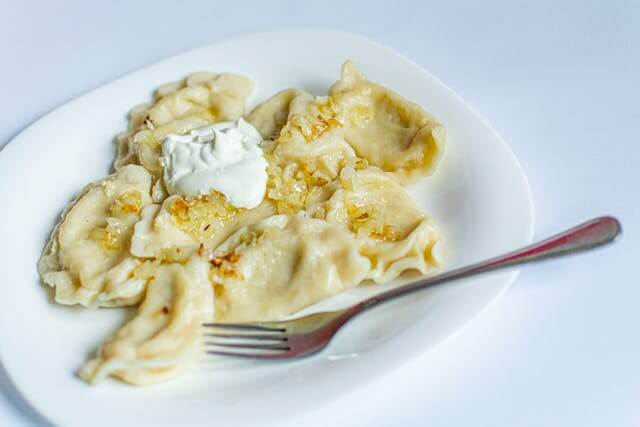
Pierogi - Traditional Polish dish
Photo: SHOX art / Pexels.com
Pierogi
Dumplings filled with various ingredients like potato, cheese, meat, or fruit
When enjoyed: Everyday meals, special occasions, Christmas
Cultural significance: National dish, symbol of Polish cuisine worldwide
Bigos
Hunter's stew made with sauerkraut, fresh cabbage, and various meats
When enjoyed: Winter meals, celebrations, traditional gatherings
Cultural significance: Often called Poland's national dish, improves with reheating
Kotlet Schabowy
Breaded pork cutlet, similar to schnitzel, served with potatoes
When enjoyed: Sunday dinners, family meals, restaurants
Cultural significance: Comfort food equivalent to American fried chicken
Żurek
Sour rye soup often served in bread bowls with sausage and egg
When enjoyed: Easter, winter months, traditional restaurants
Cultural significance: Traditional soup with medieval origins, regional variations
Makowiec
Poppy seed roll cake, especially popular during Christmas
When enjoyed: Christmas, special celebrations, coffee time
Cultural significance: Traditional Christmas dessert with symbolic meaning
Rosół
Clear chicken soup with vegetables and noodles, considered a cure-all remedy
When enjoyed: Sunday dinners, when feeling sick, family gatherings
Cultural significance: Traditional healing soup, essential part of Polish home cooking
Dining Culture Tips
Meal times: Lunch (obiad) is the main meal, typically served between 1-4 PM. Dinner (kolacja) is lighter, around 6-8 PM.
Sunday dinner: Traditional family gathering with multiple courses. Being invited shows you're considered close to the family.
Bread significance: Bread is sacred in Polish culture. Never throw it away or waste it - this is considered very disrespectful.
Polish Currency & Money Culture
Understanding Polish currency and money culture is essential for daily life. Poles have specific attitudes towards money, spending, and financial matters that reflect their history and values.
Polish Złoty (PLN)
- Official currency since 1995, replacing the old złoty
- Banknotes: 10, 20, 50, 100, 200, 500 PLN
- Coins: 1, 2, 5 PLN and 1, 2, 5, 10, 20, 50 groszy
- Poland has not adopted the Euro despite EU membership
Money Attitudes & Spending
- Poles are generally careful with money and value savings
- Card payments are very common and widely accepted without problems
- Poles frequently use BLIK (mobile payment system) for quick transactions
- Cash is still used, especially for small purchases and older vendors
- Bargaining is not common except at markets and flea markets
- Splitting bills ("going Dutch") is becoming more common
- Quality and durability are prioritized over cheap alternatives
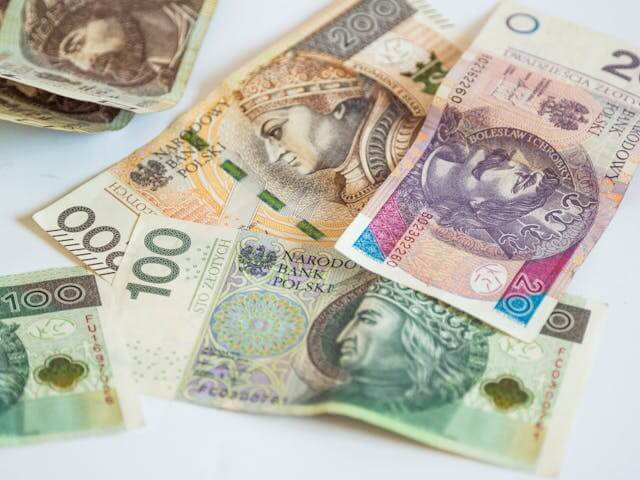
Polish Złoty banknotes and coins
Photo: SHOX art, Pexels.com
Approximate Exchange Rates
1 USD ≈ 4.00 PLN
1 EUR ≈ 4.30 PLN
1 PLN ≈ 0.25 USD
1 PLN ≈ 0.23 EUR
Disclaimer: Currency exchange rates change daily. These values are approximate and for reference only. Check current rates before making financial decisions.
Money Tips for Expats
Payment methods: Card payments are widely accepted in cities, but carry cash for small vendors, public transport, and rural areas.
Tipping culture: 10-15% in restaurants is standard. Round up for taxi drivers and hairdressers.
Banking: Major Polish banks include PKO BP, Pekao, mBank, and ING. Many offer English-language services.
Dress Code & Social Behavior
Polish culture values appropriate dress and respectful behavior. Understanding these expectations will help you feel confident in social and professional situations while showing respect for local customs.
Dress Code Guidelines
Professional Settings
- Business formal or smart casual is expected in offices
- Men: dress shirts, trousers, dress shoes (suits for important meetings)
- Women: blouses, skirts/trousers, closed-toe shoes, modest necklines
- Avoid flip-flops, shorts, or overly casual clothing in offices
Religious Places
- Conservative dress required in churches and religious sites
- Cover shoulders and knees, avoid revealing clothing
- Men should remove hats, women may cover heads with scarves
- Turn off phones and speak quietly during services
Casual & Social Settings
- Poles dress well even for casual occasions
- Clean, well-fitted clothes are preferred over designer brands
- Seasonal appropriate clothing - layers in winter, lighter in summer
- Remove shoes when entering Polish homes
Social Behavior Expectations
Public Behavior
- Keep voices low on public transport and in public spaces
- Offer seats to elderly, pregnant women, and disabled passengers
- Queue properly and wait your turn in shops and offices
- Avoid loud phone conversations in public
Social Interactions
- Maintain eye contact during conversations to show respect
- Use formal titles (Pan/Pani) until invited to use first names
- Handshakes are standard greetings in professional settings
- Personal space is important - maintain arm's length distance
Cultural Sensitivity
- Show respect for Polish history and national symbols
- Avoid controversial political discussions unless well-informed
- Be patient with bureaucratic processes - they're part of the system
- Learn basic Polish phrases to show effort and respect
Cultural Integration Tips
Seasonal awareness: Poles dress according to weather and seasons. Invest in proper winter clothing - it shows you're serious about living in Poland.
Social events: When invited to Polish homes, dress slightly more formally than you think necessary. Bring flowers (odd numbers only) or a small gift.
Professional relationships: Building trust takes time in Poland. Consistent, respectful behavior and appropriate dress help establish credibility.
Prices in Poland
Poland offers excellent value for money compared to Western European countries. While prices have increased in recent years, Poland remains significantly more affordable than most EU nations, making it an attractive destination for expats and digital nomads.
The cost of living varies significantly between major cities like Warsaw and Kraków versus smaller towns. Generally, you can expect to live comfortably on a much lower budget than in countries like Germany, France, or the UK.
Understanding Polish pricing helps you budget effectively and appreciate the economic advantages of living in Poland while maintaining a high quality of life.
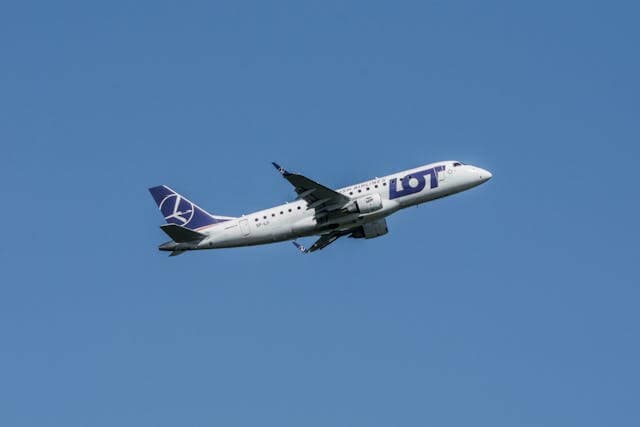
LOT Polish Airlines - National carrier
Photo: SHOX art / Pexels.com
Housing & Accommodation
| Item | Price in Poland | Comparison to Other Countries |
|---|---|---|
| 1-bedroom apartment (city center) | 2,500-4,000 PLN ($625-1,000 / €581-930) | 50-70% cheaper than London, similar to Prague |
| 1-bedroom apartment (outside center) | 1,800-2,800 PLN ($450-700 / €419-651) | 60-75% cheaper than Berlin, 40% cheaper than Vienna |
| Utilities (electricity, gas, water) | 400-600 PLN ($100-150 / €93-140) | 30-50% cheaper than Western Europe |
Food & Dining
| Item | Price in Poland | Comparison to Other Countries |
|---|---|---|
| Restaurant meal (mid-range) | 40-80 PLN ($10-20 / €9-19) | 70% cheaper than Switzerland, 50% cheaper than Germany |
| Coffee at café | 8-15 PLN ($2-4 / €2-3) | 60% cheaper than Norway, similar to Czech Republic |
| Grocery shopping (weekly) | 200-350 PLN ($50-88 / €47-81) | 40-60% cheaper than France, 30% cheaper than Italy |
| Beer (0.5L in restaurant) | 8-15 PLN ($2-4 / €2-3) | 70% cheaper than UK, 50% cheaper than Netherlands |
Transportation
| Item | Price in Poland | Comparison to Other Countries |
|---|---|---|
| Public transport monthly pass | 100-150 PLN ($25-38 / €23-35) | 75% cheaper than London, 60% cheaper than Paris |
| Taxi (per km) | 2-4 PLN ($1-1 / €0-1) | 50-70% cheaper than Western European cities |
| Gasoline (1 liter) | 6-7 PLN ($2-2 / €1-2) | 20-30% cheaper than Germany, similar to Eastern Europe |
Services & Entertainment
| Item | Price in Poland | Comparison to Other Countries |
|---|---|---|
| Cinema ticket | 20-35 PLN ($5-9 / €5-8) | 60% cheaper than UK, 40% cheaper than Germany |
| Gym membership (monthly) | 80-150 PLN ($20-38 / €19-35) | 50-70% cheaper than Scandinavia |
| Haircut (men's) | 30-60 PLN ($8-15 / €7-14) | 70% cheaper than Switzerland, 50% cheaper than France |
Cost of Living Tips
City differences: Warsaw and Kraków are 20-30% more expensive than smaller cities like Wrocław, Gdańsk, or Poznań.
Salary expectations: Average net salary ranges from 4,000-8,000 PLN depending on profession and location. IT and finance professionals earn significantly more.
Budget planning: A comfortable lifestyle in major cities requires 6,000-10,000 PLN monthly, while 4,000-6,000 PLN is sufficient in smaller cities.
Price trends: Prices have increased 20-30% since 2020 due to inflation, but Poland remains competitive compared to Western Europe.
Weather & Climate in Poland
Poland has a temperate continental climate with four distinct seasons. July is typically the warmest month with temperatures reaching 25°C (77°F), while January is the coldest with temperatures often dropping to -5°C (23°F) or lower. Each season brings different opportunities and activities throughout the year.
The country's geography creates diverse climate zones - winter brings excellent skiing conditions in the beautiful Tatra Mountains in the south, while summer is perfect for visiting the Baltic Sea coast or exploring the pristine lakes of Mazury region. Mountain areas get significantly more snow and colder temperatures, while coastal regions have milder winters and cooler summers.
Poles take weather preparation seriously and dress appropriately for each season. Having proper seasonal clothing is essential - it keeps you comfortable and shows you understand local customs. Good winter gear is particularly important given Poland's cold winters.
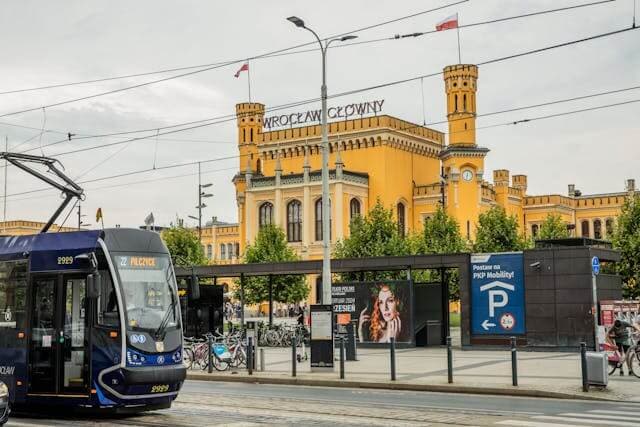
Wrocław train station architecture
Photo: SHOX art, Pexels.com
Seasonal Weather Guide
Spring (March-May)
8-18°C (46-64°F)
Mild and pleasant with occasional rain. Trees bloom and weather becomes warmer.
What to Wear
Light jacket, layers, waterproof jacket for rain
Season Highlights
- Easter celebrations
- Blooming parks and gardens
- Longer daylight hours
Summer (June-August)
15-25°C (59-77°F)
Warm and generally pleasant. Occasional thunderstorms and hot spells up to 30°C.
What to Wear
Light clothing, t-shirts, shorts, light rain jacket
Season Highlights
- Festival season
- Outdoor dining
- Long days (sunset around 9 PM)
Autumn (September-November)
5-15°C (41-59°F)
Cool and crisp with beautiful fall colors. Increasing rainfall and shorter days.
What to Wear
Warm jacket, layers, waterproof clothing, warm shoes
Season Highlights
- Beautiful fall foliage
- Mushroom picking season
- Cozy indoor activities
Winter (December-February)
-5 to 3°C (23-37°F)
Cold with snow, especially in mountains. Can be harsh with temperatures dropping below -10°C.
What to Wear
Heavy winter coat, warm boots, gloves, hat, thermal underwear
Season Highlights
- Christmas markets
- Winter sports in mountains
- Cozy indoor culture
Essential Weather Preparation Tips
Preparing for Polish weather is essential for comfortable living throughout the year. Winter preparation requires serious consideration - invest in quality winter clothing including insulated boots, a warm coat, gloves, and a hat. Polish winters can be particularly harsh with temperatures dropping below -10°C (14°F), especially during January and February.
Poland's weather can change quickly, making a layering system your best strategy. Even during summer months, carrying a light jacket is advisable for unexpected rain showers or cool evenings. This flexible approach helps you stay comfortable as conditions change throughout the day.
Each season in Poland brings unique opportunities and experiences. Winter offers excellent conditions for mountain sports and creates a cozy atmosphere for indoor cultural activities. Spring brings renewal and outdoor festivals, while summer provides ideal weather for dining al fresco and exploration. Autumn delivers stunning fall colors perfect for hiking and outdoor photography.
For accurate daily weather forecasts, local apps like Pogoda Interia provide detailed Polish weather information. While international weather services work well, local sources often offer more precise regional forecasts that help with planning daily activities and choosing appropriate clothing.
Polish Language Basics
While many Poles speak English, especially in cities, learning basic Polish phrases shows respect and helps in daily interactions. Polish is a challenging language, but locals appreciate any effort to communicate in their native tongue.
| Polish | English | Pronunciation |
|---|---|---|
| Dzień dobry | Good morning/afternoon | jen DOH-bry |
| Dziękuję | Thank you | jen-KOO-yeh |
| Przepraszam | Excuse me/Sorry | psheh-PRAH-sham |
| Miło mi Pana/Panią poznać | Nice to meet you | MEE-woh mee PAH-na/PAH-nyah POZ-nahch |
| Nie mówię po polsku | I don't speak Polish | nyeh MOH-vyeh poh POHL-skoo |
| Polish | English | Pronunciation |
|---|---|---|
| Proszę | Please/You're welcome | PROH-sheh |
| Miłego dnia | Have a nice day | mee-WEH-goh dnyah |
| Wszystkiego najlepszego | All the best | fshyst-kyeh-goh nigh-LEP-sheh-goh |
| Smacznego | Enjoy your meal | smach-NEH-goh |
| Na zdrowie | Cheers/Bless you | nah ZDRO-vyeh |
Practical Tips for Expats
Building Relationships
- Be patient - Poles may seem reserved initially but warm up over time
- Show interest in Polish history and culture
- Join local clubs, sports teams, or hobby groups
- Learn basic Polish phrases and use them regularly
- Participate in local festivals and community events
Cultural Integration
- Respect religious traditions even if you're not religious
- Try traditional Polish foods and learn about their significance
- Understand the importance of family in Polish culture
- Learn about Polish history, especially recent events
- Be patient with bureaucracy - it's part of the culture
Ready to Explore More About Living in Poland?
Understanding Polish culture is just the beginning. Explore our comprehensive guides on practical aspects of living in Poland.
Social Norms & Etiquette
Polish social etiquette is important for building relationships and showing respect. These norms help create harmony in social and professional situations.